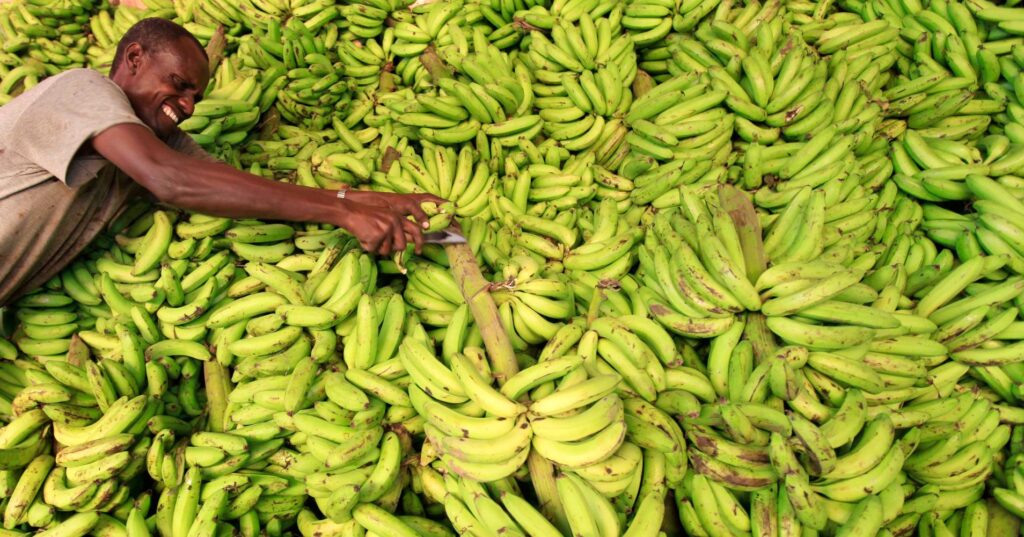- Introduction
The banana cultivation is one of the most popular and important staple foods in the world and originally comes from Southeast Asia such as Malaysia, the Philippines and Indonesia. African countries have always grown bananas, but only a few of them have excessive production with export capacities such as Ghana, Ivory Coast and Cameroon with an annual income of USD 4.3 billion.
Tanzania and Uganda are currently among the largest banana producers in East Africa and previously had low production due to low knowledge of banana cultivation among farm workers. After improving the knowledge of farm workers, banana production increased by 64% from 10 tons per hectare per year to 19 tons per hectare per year, which means an additional profit of 8.15 million dollars per year (Christine Alokit, 2020). This is a good example of how improving the knowledge of farm workers in banana cultivation is interlinked and improves banana production. Multifactorial causes can also lead to lower yields, but insufficient knowledge can make the situation worse (Christine Alokit, 2020) (Folke, 2004).

2. The Legacy of Banana Production in Somalia
Banana production in Somalia started in the 1930s in Lower Shabelle, where irrigated agriculture was developed and the main canals Primo Primario, Primo Secundario and Asyle were built under Italian colonial administration. Somalia was the largest exporter of bananas in East Africa. Its main export markets were Italy (where exports began in 1927) and the Middle East.
Before the civil war, banana yields were reported to be around 25-30 million tons/ha/year (gross), compared to yields of over 40 million tons/ha/year achieved in other banana-producing countries. The exportable yield per hectare was also rather low, as the following figures from the 1978 MacDonald report, based on data from aerial photographs and records, show. in 1978, only 165,000 hectares of this area could be irrigated. Bananas, sugar cane, grapefruit and mangoes brought the Somali farmers a considerable economic income (Gulaid, 1980).
3. Production Trends
According to FAOSTAT DATA, Somalia’s banana production from 2018 to 2022, including area harvested, total production and yield per hectare. Harvested area remained relatively stable, starting at 1,366 hectares in 2018 and fluctuating slightly to reach 1,384 hectares in 2022. Total production showed minor fluctuations over the years, increasing from 23,296.71 tons in 2018 to a peak of 23,684.31 tons in 2020 and then decreasing slightly to 23,610.48 tons in 2022. The banana yield per hectare was consistently high and stable, ranging between 17,060 and 17,061 kilograms per hectare over the five years. This stability in yields indicates consistent productivity, despite minor changes in production and harvested area.

FAOSTAT 2022
The data illustrates a significant and unfortunate trend in banana production and trade in the country from 1980 to 2022. Originally, bananas were a major export crop, with export volumes peaking in 1990 at 74,600 units, generating significant export value. However, following a sharp decline after 1990, exports fell dramatically and were almost non-existent by 2015, with value and volume tending towards zero. This reflects a collapse in the country’s banana production capacity.
In contrast, from 2015, the country began to import bananas that it had previously exported. Import volumes increased steadily, reaching 3,709.67 units by 2022, with the corresponding import values showing a growing dependence on foreign bananas. This is very disappointing considering that bananas were once a cornerstone of the agricultural economy. Before the civil war, the country not only met local demand, but was also competitive on international markets.
The shift from banana exports to banana imports illustrates the devastating impact of the civil war and subsequent economic instability. The war likely destroyed vital agricultural infrastructure, displaced farming communities and disrupted production chains. While other countries developed their agricultural sector and improved their productivity, this country struggled to recover. As a result, the country was forced to import bananas to meet domestic demand, further straining the economy.

FAOSTAT; 2022
4. Rebuilding the Banana Sector: A Call for Strategic Action
The decline from exporter to importer underscores the urgent need for strategic reforms and investment to rejuvenate the banana industry. Somalia can rebuild its agricultural sector through the following key initiatives:
- Modern Farming Techniques: Introducing improved cultivars, water management strategies, and disease-resistant varieties to boost productivity.
- Infrastructure Rehabilitation: Repairing and expanding irrigation systems, roads, and storage facilities to enhance supply chains.
- Farmer Empowerment Programs: Providing training, financial incentives, and technical support to smallholder farmers.
- Sustainability and Climate Adaptation: Implementing regenerative farming practices to safeguard soil fertility and resilience against climate change.
Reviving banana production could uplift Somalia’s economy, restore its agricultural pride, and ensure food security. By focusing on self-sufficiency and global competitiveness, Somalia has the potential to reclaim its position as a powerhouse in the banana trade.
The road to recovery requires commitment and collaboration, but with the right investments and policies, Somalia’s banana industry can once again become a symbol of resilience and prosperity.
5. Conclusion
The transition from a leading banana exporter to an importer reflects the devastating effects of the civil war, economic instability and the lack of recovery in the agricultural sector after the conflict. While other countries have developed and strengthened their banana production, this country has suffered setbacks that have undermined its competitiveness and self-reliance. The increasing dependence on imports makes it clear that it has not been possible to rebuild the once flourishing banana industry, which was a mainstay of the economy.
This unfortunate development underscores the urgent need for strategic reforms and investments to rebuild the agricultural sector. Reviving banana production through modern farming methods, infrastructure development and farmer support programs could help reverse this decline. By focusing on self-sufficiency and capitalizing on its former strengths in agriculture, the country can regain its place in the global market and secure a more sustainable future for its people.
Reference
FAOSTAT; 2022. Crops and livestock products.https://www.fao.org/faostat/en/#data/QCL
Alokit, C. (31/07/2020). Improving banana agronomy practices for small scale farmers in east africa. https://www.cabi.org/what-we-do/cabiprojects/
Gulaid, M. A. (1980). Economic tradeoffs between foodgrain and banana production in Somalia (Cilt 71). The University of Illinois at Urbana-Champaign. https://www.jstor.org/stable/4186307https://www.jstor.org/stable/4186307
Folke, S. (2004). Paper for 18th European Conference on Modern South Asian Studies, Lund, July 6-9, 2004, Panel on Institutions and agricultural development From Training and Visit Extension to Farm Women Groups: Impact-in terms of economic benefits, empowerment and institutions-of four Danida-supported training projects for farm women in India














